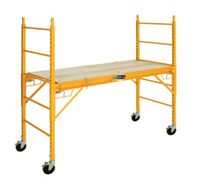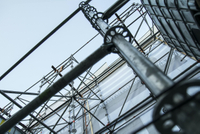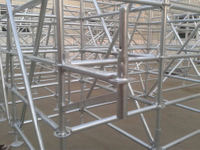Content Menu
● Understanding the Basics of Scaffolding Hoist Systems
>> Key Components
● Factors to Consider When Choosing a Scaffolding Hoist System
>> Load Capacity
>> Lifting Speed
>> Height of Lift
>> Power Source
>> Frequency of Use
>> Environment
>> Ease of Use
>> Cost
● Types of Scaffolding Hoist Systems
>> Electric Hoists
>> Pneumatic Hoists
>> Manual Hoists
>> Speciality Hoists
● Integrating Hoists with Scaffolding Systems
>> Compatibility
>> Load Distribution
>> Stability
>> Safety Devices
● Safety Tips for Operating a Scaffolding Hoist System
>> Regular Inspections
>> Operator Training
>> Load Guidelines
>> Secure Operations
>> Emergency Procedures
● Case Studies: Real-World Applications
>> Case Study 1: High-Rise Construction
>> Case Study 2: Bridge Maintenance
● Advanced Technologies in Scaffolding Hoist Systems
>> Smart Hoists
>> Remote Control
>> Automated Systems
● Conclusion
● FAQ
>> 1. What is the most important factor to consider when choosing a scaffolding hoist system?
>> 2. How often should a scaffolding hoist system be inspected?
>> 3. What type of training is required for operators of scaffolding hoist systems?
>> 4. What are some common safety devices used in scaffolding hoist systems?
>> 5. How can technology improve the safety and efficiency of scaffolding hoist systems?
● Citations:
In the dynamic landscape of construction, renovation, and maintenance projects, the efficient vertical transport of materials is crucial for optimizing productivity and ensuring worker safety. A scaffolding hoist system serves as an indispensable solution for lifting heavy loads to elevated platforms, streamlining operations and minimizing manual handling risks. However, selecting the right scaffolding hoist system can be a complex decision, influenced by various factors such as load capacity, lifting speed, site conditions, and regulatory requirements. This comprehensive guide aims to provide a detailed overview of the key considerations involved in choosing the most suitable scaffolding hoist system for your specific needs, ensuring a safe, efficient, and cost-effective operation.
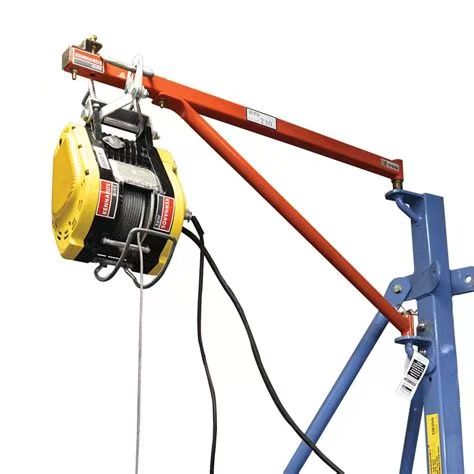
Understanding the Basics of Scaffolding Hoist Systems
A scaffolding hoist system is a mechanical device designed to lift and lower materials and equipment to and from scaffolding platforms. It typically consists of a motor, wire rope or chain, hook or lifting attachment, and a control system[3]. These systems are widely used in building construction, facade renovation, roofing, masonry work, painting, and decorating[1]. The primary goal of a scaffolding hoist system is to enhance productivity by reducing the time and effort required to move materials vertically, while also improving safety by minimizing the risk of manual handling injuries.
Key Components
- Hoist Motor: The motor powers the lifting mechanism, with varying strengths and efficiency ratings determining overall performance[3].
- Wire Rope/Chain: These components are vital, responsible for safely carrying the load. The quality of the chain/wire rope directly impacts the hoist's lifting capacity and overall durability[3].
- Hook/Lifting Attachment: These components secure the load, allowing for safe lifting/lowering and positioning at your desired height[3].
- Control System: This element includes switches, buttons, or levers to control the hoists movement (up/down), allowing operators to safely lift, lower, and position loads with the utmost accuracy[3].
Factors to Consider When Choosing a Scaffolding Hoist System
Selecting the right scaffolding hoist system requires careful evaluation of several critical factors to ensure it meets your project's specific requirements[5].
Load Capacity
The load capacity is the maximum weight that the hoist can safely lift. Always know the maximum weight you need to lift to select a hoist that can safely handle it [1, 5]. Opt for a hoist with the capacity to handle your heaviest materials[1].
Lifting Speed
A faster hoist can increase work efficiency, but ensure it also has robust safety features[1]. Lifting speed affects how quickly materials can be moved to the working platform[1].
Height of Lift
The hoist should be capable of lifting the load to the required height[5]. Consider the maximum height of your scaffolding structure when selecting a hoist[5].
Power Source
Ensure you have the necessary power supply, whether it's electrical or pneumatic[5]. The availability and type of power source on your job site will influence your choice[5].
Frequency of Use
More durable and robust hoists are needed for projects where lifting operations are frequent[5]. Consider how often you will be using the hoist to determine the required level of durability[5].
Environment
For hazardous or outdoor environments, special hoists designed to withstand these conditions are necessary[5]. Environmental factors such as weather conditions and potential exposure to corrosive materials should be considered[5].
Ease of Use
Ensure the hoist is user-friendly with intuitive controls and clear safety instructions[1]. User-friendly controls and ease of setup can improve efficiency and reduce the risk of errors[1].
Cost
While budget considerations are important, never compromise on safety features[5]. Balance initial cost with long-term operational costs and safety considerations[5].
Types of Scaffolding Hoist Systems
Various types of scaffolding hoist systems are available, each designed for specific applications and offering unique features.
Electric Hoists
Electric hoists are powered by electricity and are suitable for a wide range of lifting applications. They offer precise control and are relatively quiet in operation[5].
Pneumatic Hoists
Pneumatic hoists are powered by compressed air and are ideal for use in hazardous environments where electrical sparks could pose a risk. They are also known for their durability and ability to handle heavy loads[5].
Manual Hoists
Manual hoists, such as chain blocks and lever hoists, are operated by hand and are suitable for light-duty lifting tasks in situations where power is not available. They are simple, reliable, and require minimal maintenance[5].
Speciality Hoists
Specialty hoists are designed for specific lifting tasks, such as material hoists for construction sites and personnel hoists for transporting workers[4]. These hoists often incorporate advanced safety features and are designed to meet stringent regulatory requirements[4].
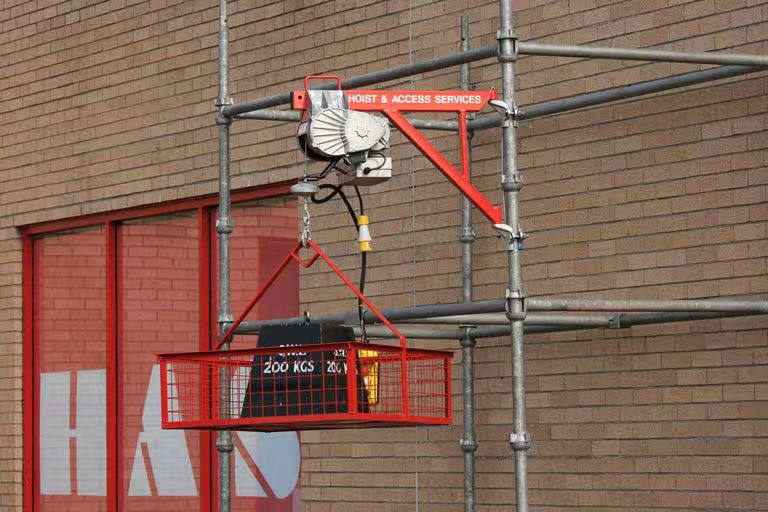
Integrating Hoists with Scaffolding Systems
The integration of a scaffolding hoist system with the scaffolding structure is a critical aspect of ensuring safe and efficient material handling.
Compatibility
Ensure that the hoist system is compatible with the type of scaffolding you are using[7]. Different scaffolding systems may require different types of hoist mounting and support structures[7].
Load Distribution
Properly distribute the load to prevent overloading any part of the scaffolding structure. Consult with a qualified engineer to determine the load-bearing capacity of the scaffold and the appropriate placement of the hoist[7].
Stability
Ensure that the scaffolding is stable and securely anchored to prevent tipping or collapse during lifting operations. Use outriggers and tie-backs to enhance stability, especially when lifting heavy loads[7].
Safety Devices
Incorporate safety devices such as overload protection, limit switches, and emergency stop mechanisms to prevent accidents and ensure safe operation. Regularly inspect and maintain these devices to ensure they are functioning correctly[2].
Safety Tips for Operating a Scaffolding Hoist System
Proper operation and maintenance are key to maximizing the safety and longevity of your scaffolding hoist system[1].
Regular Inspections
Perform routine checks to identify and fix any potential issues[1]. Inspect the hoist, wire rope, hooks, and other components before each use[1].
Operator Training
Ensure operators are fully trained and aware of safety procedures[1]. Provide comprehensive training on the proper use, maintenance, and inspection of the hoist[1].
Load Guidelines
Never exceed the recommended load capacity to avoid overloading the hoist[1]. Clearly mark the load capacity on the hoist and ensure that operators are aware of the limits[1].
Secure Operations
Always confirm that the load is securely attached and stable before lifting[1]. Use appropriate lifting attachments and ensure that the load is properly balanced[1].
Emergency Procedures
Establish clear emergency procedures and ensure that all workers are familiar with them. Conduct regular drills to practice emergency response protocols[1].
Case Studies: Real-World Applications
Case Study 1: High-Rise Construction
A construction company used a scaffolding hoist system to lift materials to the upper floors of a high-rise building. The hoist system significantly reduced the time and labor required to move materials, resulting in cost savings and improved project timelines[4].
Case Study 2: Bridge Maintenance
During a bridge maintenance project, workers used a scaffolding hoist system to lift heavy equipment and materials to the work platform. The hoist system improved safety by minimizing the need for manual lifting and reducing the risk of falls[4].
Advanced Technologies in Scaffolding Hoist Systems
Advancements in technology are continuously improving the safety and efficiency of scaffolding hoist systems[4].
Smart Hoists
Smart hoists incorporate sensors and monitoring systems to detect potential hazards, such as overloading or mechanical failures. These systems can provide real-time alerts and automatically shut down the hoist to prevent accidents[4].
Remote Control
Remote control systems allow operators to control the hoist from a safe distance, reducing the risk of injury. These systems also improve precision and control, especially when lifting heavy or delicate loads[2].
Automated Systems
Automated scaffolding hoist systems use robotic technology to lift and position materials with minimal human intervention. These systems improve efficiency, reduce labor costs, and enhance safety[4].
Conclusion
Choosing the right scaffolding hoist system is a critical decision that can significantly impact the safety, efficiency, and cost-effectiveness of your project. By carefully evaluating factors such as load capacity, lifting speed, site conditions, and regulatory requirements, you can select a hoist system that meets your specific needs and ensures a successful operation. Proper installation, maintenance, and operation of the hoist system are essential for maximizing its benefits and minimizing the risk of accidents. Embracing advanced technologies and adhering to best practices will further enhance the safety and efficiency of your scaffolding operations, creating a safer and more productive work environment.
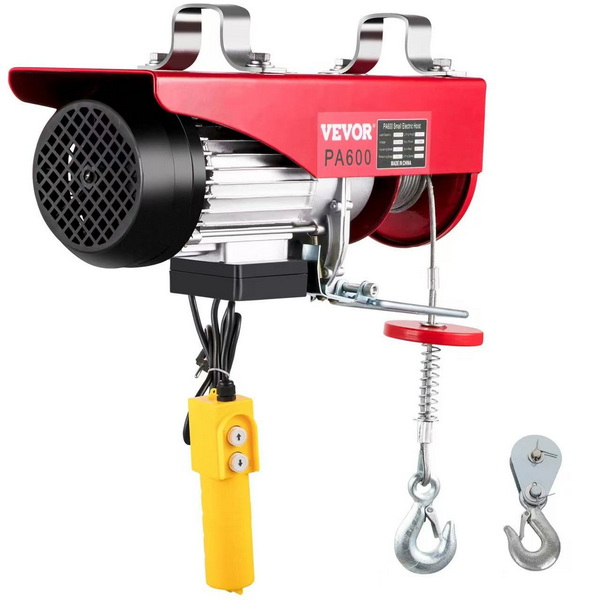
FAQ
1. What is the most important factor to consider when choosing a scaffolding hoist system?
The most important factor is the load capacity of the hoist. Ensure that the hoist can safely handle the heaviest materials you need to lift.
2. How often should a scaffolding hoist system be inspected?
A scaffolding hoist system should be inspected before each use to identify any potential issues and ensure safe operation.
3. What type of training is required for operators of scaffolding hoist systems?
Operators should receive comprehensive training on the proper use, maintenance, and inspection of the hoist, as well as relevant safety procedures and emergency protocols[1].
4. What are some common safety devices used in scaffolding hoist systems?
Common safety devices include overload protection, limit switches, and emergency stop mechanisms, which help prevent accidents and ensure safe operation[2].
5. How can technology improve the safety and efficiency of scaffolding hoist systems?
Smart hoists, remote control systems, and automated systems can enhance safety and efficiency by providing real-time alerts, improving precision, and reducing the need for manual intervention [2, 4].
Citations:
[1] https://admalite.com/scaffolding-hoist-an-essential-guide/
[2] https://www.youtube.com/watch?v=8xPLykTc9Ok
[3] https://liftingequipmentstore.com/collections/scaffold-hoists
[4] https://nonstopscaffolding.com/hoist/
[5] https://www.scaffoldresource.com/types-of-hoists/
[6] https://www.istockphoto.com/videos/scaffolding-system
[7] https://www.saiaonline.org/files/SSFI%20Tech%20Bulletin_Supported%20Scaffold%20Selection%20Guide%20NEW.pdf
[8] https://www.shutterstock.com/video/search/system-scaffolding
[9] https://www.safemanitoba.com/Page%20Related%20Documents/resources/GD_ScaffoldsAndOtherElevatedWorkPlatforms_16SWMB.pdf













